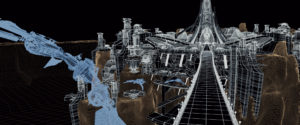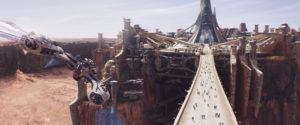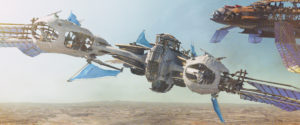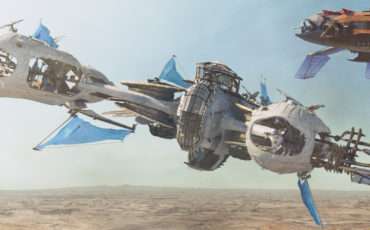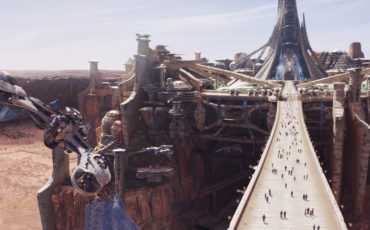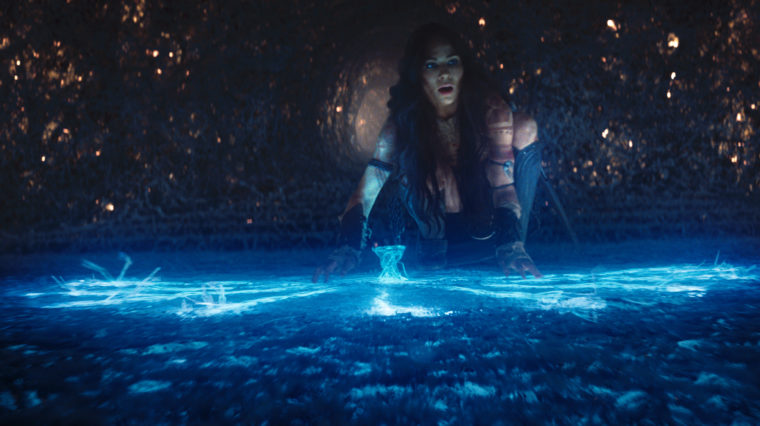
CG Society: Production Focus – John Carter
What does it take to create a planet? A lot more effort than can fit in a seven day week. Ask the hundreds of artists at Cinesite who spent two years creating Martian environments, cities and airships for Disney’s film John Carter, or the 120 animators plus several hundred in the supporting cast at Double Negative who created the big green aliens who populated the planet.
Double Negative’s Peter Chiang was overall visual effects supervisor for the film with visual effects supervisor Sue Rowe managing the crew at Cinesite. Also playing god for the action-adventure film was the Moving Picture Company where artists supervised by Adam Valdez created even bigger green aliens and visual effects for the « Warhoon » battle sequence.
Pixar’s Andrew Stanton, who most recently directed the animated feature Wall-E, for which he won an Oscar, helmed the film, his first live-action movie, borrowing Pixar’s general manager Jim Morris and producer Lindsey Collins to act as his producers, and writer Mark Andrews to work with Stanton and Michael Chabon on the script. « We also brought in a couple people from Pixar at key times as consultants, » Stanton says. « But that was it. This is a Disney film; it isn’t Pixar’s first live action film. We had to keep the lines clean. »
Filmed in the Utah desert and on sound stages in London, the film brings to life Edgar Rice Burroughs’ classic novel ‘A Princess of Mars,’ one of the first science fiction stories to send an American onto another planet, and one of the first interplanetary romances. The time is soon after America’s civil war. John Carter (Taylor Kitsch), a dispirited veteran, finds himself teleported to Mars, a planet with two warring tribes of people that look something like him, the Zodangans and Heliumites played by actors, and more alien-looking, four-armed, noseless green-skinned humanoids called Tharks, which are always CG characters based on actors’ performances.
In the reduced gravity of this planet, John Carter becomes a superhuman who can leap tall aliens. He befriends Tars Tarkas (Willem Dafoe), one of the few green-skinned Tharks capable of expressing friendly emotions, and he falls in love with a Heliumite princess, Dejah Thoris (Lynn Collins).
Drawing on his experience at Pixar, Stanton storyboarded many of the scenes with visual effects and CG characters, but not those without effects. « I’d previs the sequences that were incredibly complex and effects heavy almost to the level of a cheaply animated 3D picture, » he says. « And when John Carter is talking to a nine-foot-tall Willem Dafoe, I boarded those scenes more loosely. Sometimes we’d rehearse and block out the scenes. But, I wanted to learn the thrill of being impulsive in the moment with the actors and the camera. I didn’t want to close that door. I come from theater, way back — I thought I would go into acting until my late teens. So, I was thrilled to be working with actors on set; I wanted to experience that spontaneity. »
That spontaneity even included sandstorms. « Most of our equipment was ruined in Utah, » Rowe says, « and we were holding our coats over our eyes, but in one of the opening shots you see our ships flying through a sandstorm. Fortunately, we had good reference. »
Because Burroughs wrote the book 100 years ago, and the setting is even further back in history, Stanton wanted to play off its old-fashioned feel. « It’s science fiction seen through the eyes of somebody at the turn-of-the-century, » he says. « I wanted to be in real locations and make it feel like I was really in that time whether I was on Earth or Mars. I thought the way into the film was not so much trying to be fantastical, but actually the opposite. To present [Mars] as if it’s another travel destination, an exotic location that’s in our universe, but we just didn’t know anything about it. We went looking for landscapes where the rocks already had centuries of erosion and then did the tiniest bit of computer work on them to give the illusion that they were constructed ruins. »
Helium
Within that landscape, Cinesite artists built the ‘Martian history’, the warring cities of Zodanga, which is a mile-long mining ship that walks across the surface of the planet, and Helium, a more traditional city; the Thern sanctuary, and multiple, solar-powered air ships. Sometimes Cinesite created set extensions, sometimes entire CG environments. Teams of modelers, worked together in one big group at the beginning \0x2013 one group rendering Helium, another the ships, and a third, Helium. Once the post-production moved into creating sequences, they moved onto individual teams. Modelers worked with Autodesk’s Maya, compositors with the Foundry’s Nuke; Rendering was through Pixar’s RenderMan.
Rowe describes Helium, a city that invests in the wellbeing of its citizens, and Princess Dejah’s home, like a blue drop of water. « They built Helium in a place in North London that had been a warehouse for Woolworth shopping, » Rowe says. « It was very strange, but they needed a lot of interior ground space for a battle, so that was great. But, we had no height. » Cinesite artists added that height.
Working from previs that Stanton had directed and Halon had created, Rowe devised a technical previs that showed what Stanton would see when the camera looked up beyond the room and outside the greenscreen. « Helium is an erudite, Zen-like city, » Rowe says. « With a temple in the middle, all made of glass. »
Zodanga
The Zodangans, a race of Martians who believe in every man for himself, reside in a grittier environment.
« The city picks a spot, hunkers down, takes what it wants, and then moves on, » Stanton explains. « The city is always moving; it’s sort of like a moving refinery that goes to different locations and drills for Radium, which is a resource that is getting depleted. » Jon Neill, who supervised the Zoodangan sequences, worked on the film for two and a half years.
« Imagine a massive aircraft carrier that walks on the ground, » Neill says. « On the deck are fighting warships, and smaller fliers on the hangar deck below. It’s as tall as a five story building, and under it are 674 legs and the mining drill. » Inside the city ship, the ‘haves’ live in towering penthouse palaces at the top; the workers live below.
« We have market stalls on the lowest floor with people wandering about shops and cafes, » Neill says. « It’s grungy, with lots of steam. Then, we have all kinds of open apartments where you can see right in. Everything is interesting and detailed. » To create the crowds, Cinesite uses Massive software. Jane Rotolo supervised the crowds. « We used Massive, but Jane went on the motion capture shoot with the stunt guys and directed them, » Rowe says. « She had them do multiple actions — walking, running, stabbing, all the things we could think of. Then, she populated all the cities with our 3D crowds. I could look at thousands of tiny people and in reality there were only four people in the foreground. I was so impressed. »
Working from concept art created by Ryan Church, a team of modelers built a generic city used for wide shots and then, once the studio received previs and storyboards, created detailed areas used for close-ups.
« They had a massive set at Longcross [Studios in Surrey, England] for the streets, but because the city is so big, after 20 meters you would be in a digital world, » Neill says. « We also had a set for the hangar deck, but we ended up painting that out and replacing it. That’s why I picked this sequence. I really liked the idea of building a walking city. The extensions were massive and we had all CG shots, too. »
Lidar scans helped the artists create accurate CG extensions that they could bolt onto the sets, and provided geometry for camera tracking. « We also took pictures of each prop, » Neill says. « Hundreds and hundreds of pictures. We had a team of modelers recreating each individual prop. » Layout artists then created groups of props to dress the stalls and apartments.
« It was like having a dollhouse with all its toys, » Neill says. « The amount of 3D polygons was incredible. I think we had something like two billion polygons, so we had to build optimization tools to deal with all this. » An intelligent mesh caching system made it possible for lighters to load in proxy models that would turn back into geometry at render time.
« We also had tools that would get rid of any geometry that wouldn’t be seen or contribute to the render, » Neill says. « It was all raytraced in RenderMan; we used global illumination. But, we did some tweaks and fixes. We baked the raytracing into a file, and we baked surface color using 3D point clouds. The accumulation of tools like that made this thing work. »
In addition, all along the streets filled with shops and apartments are hundreds of dirty, ragged flags and banners in the red and black Zodangan colors. The penthouses had more polished surfaces and newer flags.
« All the flags were cloth sims, » Neill says. « We also had steam vents and because these layers are so far down, we get pockets of light hitting the floor with steam floating through that. So we had volumetric light shafts. We built wooden scaffolding and used the flags and drapes like you would on a set to add depth and scale. The director wanted us to take our cues from the ships in ‘Master and Commander.' »
The massive city moved using three types of legs, each with hundreds of moving parts. « We did three or four different animation cycles and used them randomly, » Neill says. « As one leg raises, the one next to it raises two frames later, like a centipede. And, of course, the city was walking so we had dust hits. When the legs hit the surface we created a dust explosion with Maya fluids. We modeled the ground and repainted details like stones seen close-up in Mudbox. » Digital stills taken on location in Utah became textures for some areas to add further details.
Solar Airships
The modelers and texture artists also built Zodangan corsairs, which landed on the airfield deck, the fliers on the deck below, a huge Zodangan flagship that rescues John Carter at the end of the Warhood attack, and two Helium airships. Cinesite visual effects supervisor Ben Shepherd managed the crew that sent the ships into the opening battle sequence and into an aerial battle.
Stanton compares the airships, which glide through the air using light bouncing from the surface of the planet, to tall ships that move with wind in their sails. Making it possible to capture enough light to move the huge airships are solar wings that spread out for hundreds of meters. Zodangan ships are dark, made from material that looks like polished mahogany, but old mahogany. « The surface has a fine crackling, » Shepherd says. « The Helium ships are more ornate. They feel like they’re made from old white ceramic tiles that have fine hairline cracks in them. »
The wings were the most difficult for the crew \0x2013 difficult to design, animate, and render. « They look like flattened disco balls, » Shepherd says. « I’ve forgotten how many thousands of tiles they have that refract and reflect light. They shimmer like a shoal of mackerel when they power up and all the individual tiles realign themselves in a wave that goes down the length of the wing. We used procedural animation but it took a lot of hand tweaking and grunt work by the animators. »
The animators worked from previs to create the opening sequence and a complicated aerial battle. « There was a lot of popping and changing going from inside a city looking up, to inside the ships moving down, » Shepherd says. « We were constantly tweaking and maneuvering the wings depending on what the ship was doing, and how much of the glittery, shiny wings we wanted to see, » Shepherd says. « And, it took ages and ages to pin down the animation in terms of how much float and wobble to give the wings to make them believable. »
On the ships themselves, details helped make the fantastic seem possible. « No one has seen a big, floating wooden ship with wings that look like a cross between a dragon fly, a disco ball, and a lobster, » Shepherd says. « We needed to ground it in reality, so we filled it with true grit. And people. When we first matched the design, the ships looked like miniatures. I felt like that was a compliment. But, getting the scale right was tough. We had to go back and add ropes, cleats, hooks, all those details, and more crowds to make you feel like the ship had a crew of 200 people. The intelligent, strategic use of digital Massive crowds helped get the scale right. When the ship banked, we’d fill it with people running up and down the decks, handling munitions, pulling cables, looking around. They gave the ships activity, and life, and scale. »
A gimbaled set on location made it possible for Stanton to film the live action actors on the ship decks. « We did a lot of shots of John Carter walking from the live action set onto our CG ship extensions, » Shepherd says.
Building the cities and ships was only part of Cinesite’s task: The crew at Cinesite made John Carter fly and created the magical Thern effect.
The Thern Effect
Like a Lego set of building blocks, the electric-blue Thern, about the size of a fiber optic strand, can grow, combine, and transform itself into different entities – a gun, a control panel, a sword, a corridor that forms in front of people as they walk forward, an entire room.
Cinesite’s Simon Stanley-Clamp supervised the Thern sequences including the 80 shots of Thern forming an entire sanctuary, its walls built with a basket-weave of neon squiggles.
« There was look-development for about a year before I got involved, » Stanley-Clamp says. « I picked up the core elements and art-directed it to the final look. We derived the look from initial art department concepts and tests. The idea is that it’s like nanotechnology, like a Mandelbrot, that looks the same close or far away. We deemed the best way to reproduce it in a mathematical way would be to use Houdini. »
Artists build the Thern in Autodesk’s Maya, grew the effect with Houdini, and rendered it in Pixar’s RenderMan. CG supervisor Artemis Oikonomopoulou describes the process: « The director had an idea in mind, but it was abstract, » she says. « So we did a lot of concept work. Once we had a DNA model of a Thern that he liked, we used that as our basis and then wrote our tools. We used Houdini because it has a long history of L-systems and recursive techniques. The DNA model looks like branches of a tree stuck together, like a hedge, maybe a dead tree. »
« Once we had the look, we tried different techniques to make it grow into a whole room, » she says. « We tried L-systems and Voronoi fractals, but they were too regular. The Thern is meant to be mechanical yet organic. We wanted to make some branches bigger, some longer, some thinner, some fatter. After around eight months of R&D, we came up with the algorithm to model this for the whole room and animate it. Creating something solid with properties we could animate was the tricky part. »
« To keep the geometry light, every strand created was replaced by cylinders that are blended together to create smooth joints at render time. The director wanted a creepy movement from an unknown entity that was building the room. So, we split every strand into subsections so each section could be animated on its own. There were three ways to animate the branches, and the animators could control the percentage of each type of animation. Basically, we built animation tools that animators could use in a procedural way. »
« We had deadline after deadline after deadline, » Neill says. « I was on the show for two and a half years, so I got used to it after a while, but it was relentless. I had to pace myself. »
Now, though, he and the crew are beginning to see the result of all that effort. « I’m able to look at the sequences without seeing the pain and think, ‘Oh, they’re quite good,' » Neill says.
Adds Shepherd. « Making people believe John Carter can fly. Making ships that fly. It was a fantastic challenge. I genuinely loved it. »

